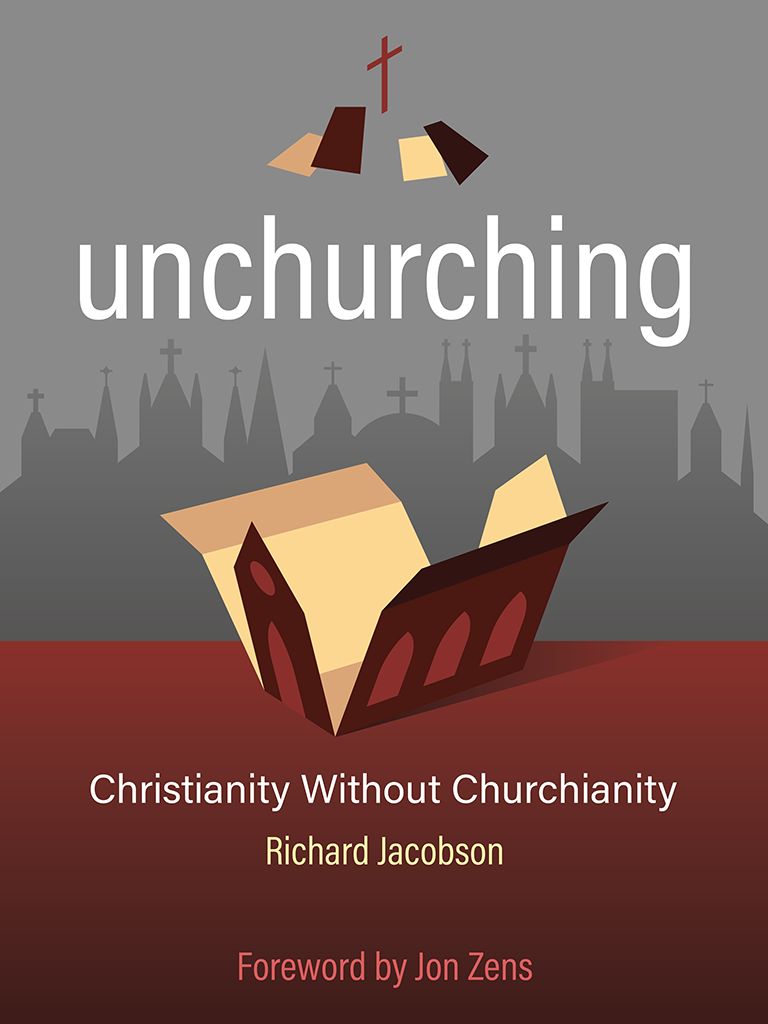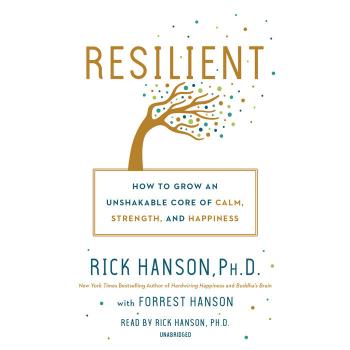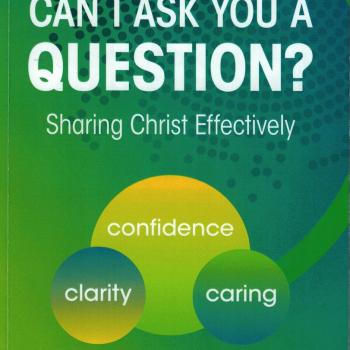Unchurching by Richard Jacobson
Unchurching by Richard Jacobson defines the purpose of the book with the subtitle: “Christianity without Churchanity.” He opens with the appropriate quote from Richard Halverson, former chaplain of the United States Senate (10):
In the beginning the church was a fellowship of men and women centering on the living Christ. Then the church moved to Greece, where it became a philosophy. Then it moved to Rome, where it became an institution. Next, it moved to Europe, where it became a culture. And, finally, it moved to America, where it became an enterprise.
Jacobson, a self-described church anarchist, used an animated blog to help him on his journey of faith. He had a self-described crisis of faith, which caused him to re-evaluate the meaning of church. In Part One, Jacobson describes the theological reasons why the church should be as a spiritual community. He came to the conclusion that the church is not a building, not a tradition, but a people of faith, a community. He bases his belief of a church as community on the community of God the Father, God the Son, and God the Holy Spirit in eternity. Like the Trinity, the church should be a redemptive community, sharing resources and roles, and reflect unity in the world.
In Part Two, Jacobson reveals the importance of Christians in the church community as spiritual parents (45). In his argument about church leadership, Jacobson insists that the gender of the leader of the church does not matter. He says that the original Greek contains no article to suggest male leaders. He insists that modern translations reflect a gender bias based upon tradition (49). Even if the masculine pronoun is not in the Greek in 1 Timothy 3:1, the word used for husband in 1 Timothy 3:2 (andra, meaning “married man” used in a majority of cases as the man or male in the New Testament) clearly defines the gender of the pastor. Jacobson counters with the following argument (49):
The only requirement for overseers that is specifically directed toward men is the requirement for overseers to be faithful to their wives. Because of this, translators often assumed this entire passage is specifically directed toward men. But it is equally possible this one requirement was specifically directed to the male overseers and the rest of the requirements were directed toward both men and women.
Frankly, I consider this explanation weak. The translators did not “assume” the entire passage. They used the rules of context to guide their translation. The argument lays with someone like Jacobson to prove his argument is true, than to assume that the original argument used by translators is false. This brings me to my concern with a book like this. I agree, the culture of church is restrictive and difficult at times. Yet, Jacobson’s argument is internally consistent. In Part Two, he performs eisigesis (he inserts his beliefs into the Biblical text). He does not spend time arguing the same point about gender with other verses such as Hebrews 13:7 or 1 Peter 5:2-3 (51-52). I would agree with his modern assessment about the role of church leaders (52):
Based on the requirements we find in scripture, we now know the original overseers were not church administrators who held some kind of office but spiritual parents who lived day-by-day alongside their spiritual children like shepherds, not unlike Jesus, the Good Shepherd.
Jacobson promotes the idea of a plurality of elders. He wants to suggest that it would bring back the purest form of Biblical community. The problem is that we don’t live in a perfect world, much less perfect churches. Contextualization dictates that smaller churches may not be able to be led by a plurality of elders. He continues in his analysis of the Greek about the role of leadership of the church. Throughout, he inserts the potential for female leadership. He uses the Old Testament prophecy in Joel 2:28-29 as a prescription for female leadership. While I agree that church pastors should function as “spiritual parents” (56), and if these roles are a “reflection of the Father,” then the argument’s logical conclusion should be that pastors are male.
Jacobson continues his gender-neutral argument for deacons, where he makes a more logically consistent, Biblical position. There is the possibility for deacons to be female. The case can be made for female deacons (based on Romans 16:1) One could conclude that Paul’s instruction for the deacon also includes requirements for a deacon’s wife (1 Timothy 3:11). One could further conclude based on the Greek word that the wife could be a deacon. Yet, I maintain that one should not perform Biblical gymnastics to try to prove a point that the Bible never teaches. Instead, one must maintain that perhaps the role of the women (whether it is the pastor’s wife or the deacon’s wife) is to support the husband.
Jacobson continues his gender-neutral argument for deacons, where he makes a more logically consistent, Biblical position. There is the possibility for deacons to be female. The case can be made for female deacons (based on Romans 16:1) One could conclude that Paul’s instruction for the deacon also includes requirements for a deacon’s wife (1 Timothy 3:11). One could further conclude based on the Greek word that the wife could be a deacon. Yet, I maintain that one should not perform Biblical gymnastics to try to prove a point that the Bible never teaches. Instead, one must maintain that perhaps the role of the women (whether it is the pastor’s wife or the deacon’s wife) is to support the husband.
Jacobson correctly identifies the roles of certain ministers in Ephesians 4:11-13 as people who equip other members of the church to maturity (64-65). He explores the dangers of organizational hierarchy in the church. He states a valid critique of the current church management system (69):
Such a church model is designed to produce many life-long learners but very few teachers. Or to put it another way: Sunday School is the only school from which no one ever graduates. But Christ wants us to graduate and become a true priesthood of all believers, empowered to exercise genuine spiritual authority.
Jacobson does a great job explaining the importance of spiritual authority in the church (71). He wisely warns the church about adopting corporate structures as the primary way of organizing in the church. This leads us to Part Three: Church Incorporated.
Jacobson begins by comparing our present church worship structure to the time of Ezra in Nehemiah 8:2-4, Nehemiah 8:6, Nehemiah 8:8, and Nehemiah 8:12 (76-77). He warns that the New Testament church does not contain the same elements. He explains his reasoning in the following way (78):
The reason why we cannot find any examples of our current church model in the New Testament is the same reason we cannot find any details about early church programs, policies or procedures. The fact that these details are noticeably lacking is actually one of the biggest clues about the way the early church functioned.
Jacobson insists that the early New Testament churches were just communities made up of families. He insists that the church is a family (Galatians 6:10). It functions like a family (1 Timothy 5:1-2). He warns the reader that the church as a congregation (a family) should not give up their true identity with an Americanized one: the corporation. A Corporation is designed as a legal entity to protect people. The corporation as a legal entity should never replace the church as a faith community (82).
Jacobson addresses organizational hierarchy in the Old Testament and compares it with what Jesus instituted. He compares the command and control structure presented by Jethro in Exodus 18:21-22 (90) to the alternative presented by Jesus (Matthew 18:15-17). Jesus suggested that people resolve their differences in circles of community. Jethro urged Moses to use higher forms of hierarchy. Jesus urges us to reach outward to the wider community.
Jacobson extends this idea to gender roles in the church. He believes in egalitarianism. He believes that Paul was egalitarian, even though there are Bible verses that seem to show otherwise. Slaves and freemen have equal status and standing in the church. In the same way, men and women have equal standing in the church. Jacobson tries to deal with the difficult passage that speaks against his claim (like 1 Corinthians 14:35 where women are told be silent in church.) Jacobson explains rightly that God’s ultimate goal is to restore all things. God is a God of reconciliation. Jacobson states that gender inequality came as a result of sin. God’s plan would be gender equality in the church (101). He states that Joel 2 prophesies that there would soon be no gender inequality. His point is one to consider (101):
If the subjugation of women was not part of God’s original plan for creation, then how can it be part of his ultimate plan for the church? His ultimate plan was to create a priesthood of all believers. How is that even possible if 50% of the church is ineligible to truly function as fellow priests because of their gender? It seems somewhat paradoxical that the early church was counter-culture precisely because they embraced gender equality yet many of today’s churches are becoming counter-culture precisely because they oppose it.
Jacobson compares the ministry of the megachurch and the house church (104). He states that the house church ministry models the work of Jesus – going from a few to the crowds. Books like The Purpose-Driven Church by Rick Warren (which I reviewed) seem to prove his point. However, I believe that a church can work through both directions, because I believe Jesus addressed three different groups: (1) the disciples, (2) the congregation, and (3) the crowd.
Jacobson confronts the modern “storefront” model for church growth and effectively argues that the family illustrates the natural growth of the church. He uses the illustration of the family to show important characteristics of the church (106). Jacobson advocates for the complete participation of all of the people in the church. He compares to the lack of this participation to raising veal. In his illustration, he shows that the veal (and by extension the people in the church) die when they are overfed but not given a chance to exercise (114).
In Part Four: Church Outside the Box, Jacobson encourages a paradigm shift. Again, he strongly suggests that churches pursue community (122), experience worship (124), and share power (126). He strongly believes in the idea of the “priesthood of believers” that breaks down barriers and hierarchy in the church. Jacobson shares a brief defense of the questions he raises (135). He reminds us that there are many people who are leaving the church. Jacobson explains that (138):
This book wasn’t written to try to convince anyone to leave the institutional church; it was simply written to validate and empower those who already have a growing conviction to do so.
With this statement, he joins other postmodern church leaders like David Hayward. I can appreciate the frustration that Jacobson feels, even if I am a pastor of a church. He gives statistics to defend his position (139):
According to a recent survey by The Barna Group, over the past 10 years, the number of non-churchgoers in America has grown by 38 million which is an increase of more than 30%. To put this in perspective, that is more people than the entire population of Australia (24 million) or the entire population of Canada (36 million).
Jacobson states that these statistics are bad if you want to maintain the status quo, because membership is declining. These stats are good news if you believe that the organized church model needs to be discarded (139). Jacobson doesn’t advocate isolation. Instead, he suggests that church community as we know it must change (141). While Jacobson encourages Christians to make an exodus away from the organized church, he hands off the journey to the Promised Land to Milt Rodriguez, author of Starting Organic Churches.
Jacobson never promises how to operate the new church community he proposes (143). One reads of some vague characteristics of gender equality, and an equal playing field where everyone gets to participate. He says that we need to be followers of Jesus. In the end, the question of leadership in this church community is never addressed. Jacobson has grand ideas, but without a discussion of leadership, he will never show how to get these great ideas set in motion. As John Maxwell once said: “Everything rises and falls with leadership.”
Jacobson ends the book with a challenge to spread the word. He shares the Unchurching website, as well as his contact information. He has produced videos which complement this book. I was impressed how the videos explained his views in a simple and understanding way. I would recommend the book for people who want to see opportunities to learn how to return to how church should really be. Viewing his lessons on the website would be helpful as well.
Disclosure of Material Connection: I received this book free from the author and/or publisher through the Speakeasy blogging book review network. I was not required to write a positive review. The opinions I have expressed are my own. I am disclosing this in accordance with the Federal Trade Commission’s 16 CFR,Part 255.













